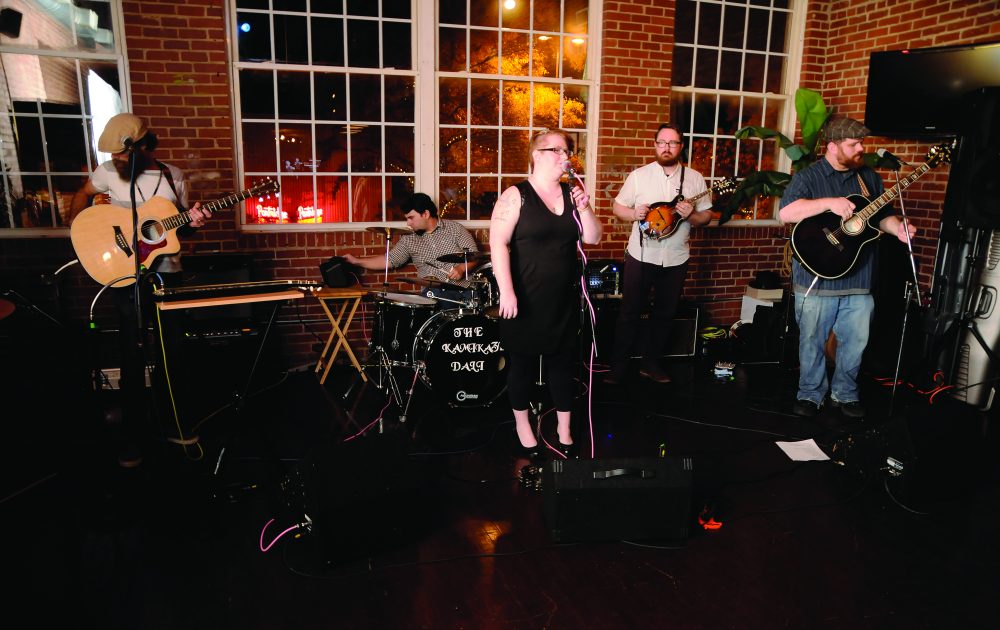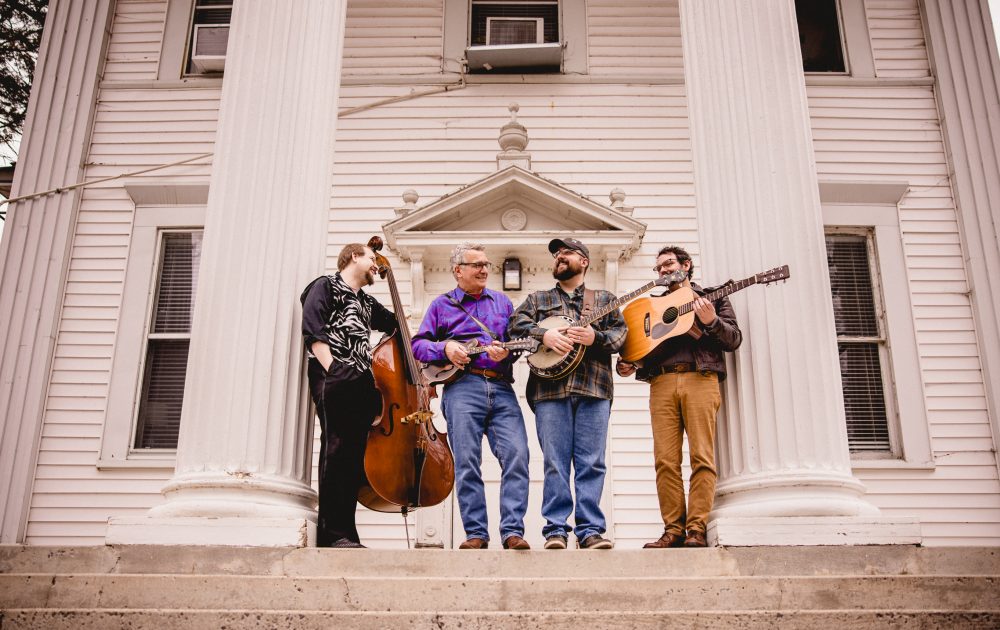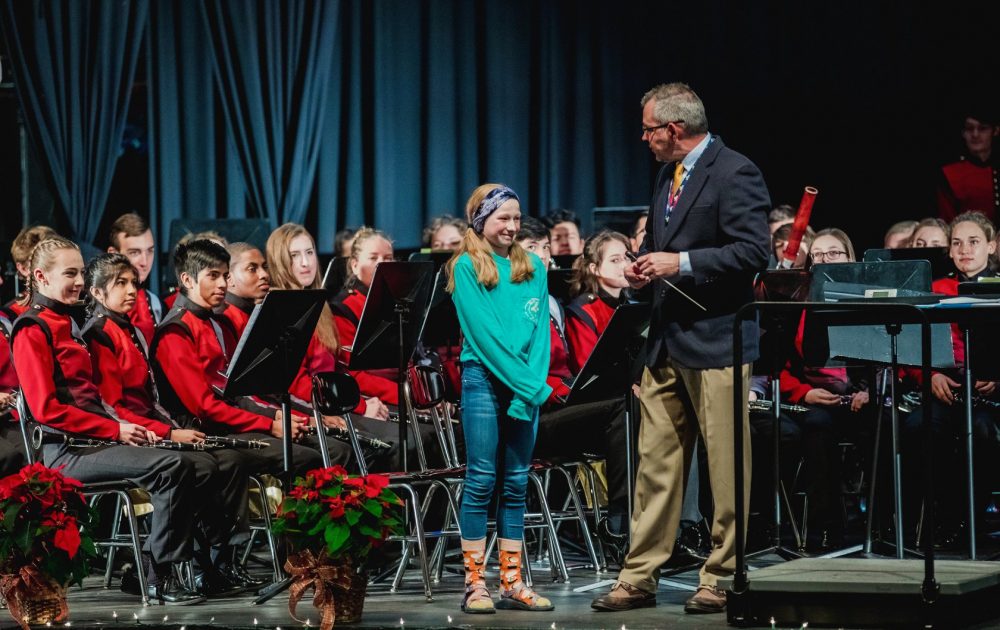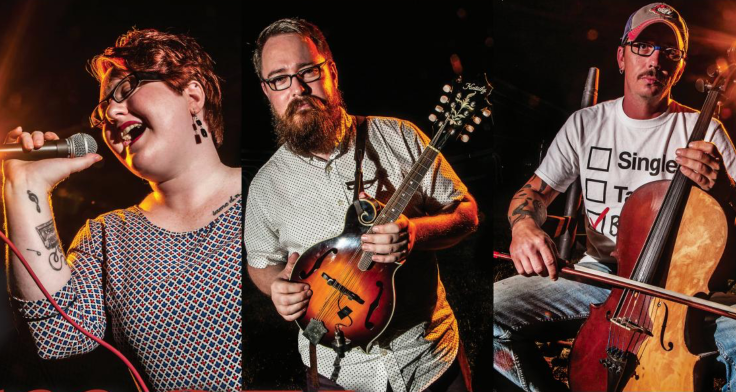
Photos by Derek Bell
The hazy onset of dusk casts shadows against faces and upon shoes; there’s a photo shoot underway. Sporadic bolts of flash illuminate each individual instrument clutching member of a six-man band that, together, forms one hell of a musical mitochondria.
The name, The Kamikaze Dali, arose from the dream-world slumbers of first founding member, singer/songwriter and guitarist Jeremy Wells. For years, Wells, 37, played under various Dali-like aliases, but since the dawn of 2013, the name has discovered and rested upon a hexagonal harmony that consistently experiences what singer Kara Headrick, 26, jokingly refers to as “Disneyland magic.” It only takes an amount of minutes with the band to see that it’s actually the perfect description for the Dali’s melodious chemistry.
Rounding out the six-man circle are Jason Murphy, 37, mandolin and guitar; Kevin Weaver, 31; guitar and vocals; Chris Clark, 37, bass; and Adam Bowman, 31, percussion – none of whom are limited to the instruments listed.
Poetic fire, feeding off the passions and poisons of life, makes for fierce songwriting and honest lyrical composition. That fire meets its fan with the Dali’s unique melodic arrangements and a three-part harmony that could serenely awaken a sleeping soul.
To understand the convoluted way that the band finally merged their talents is to play a game of six degrees of the Dali. The truth is, they’ve all just been stumbling over each other since adolescence. Forming a wide circle around the room of the Dali’s practice space in Wells’ home, the band takes turns putting this into perspective.
Bowman takes the first go at it, “It’s kind of weird; everybody has intertwined at some point. Chris jammed with Kevin who jammed with me, and then we jammed with Jason and Kara before I even knew Jeremy.”
Headrick chimes in, explaining that Clark played music with both Weaver and Wells, separately, throughout high school. Weaver eventually joined the jam between Wells and Clark, about which, Wells says, “It clicked like nothing else.”
Once Weaver brought Murphy and Headrick into the mix, the shining lights of The Magic Kingdom came into view. A percussionist was the last piece of the Dali puzzle, and they all wondered why they hadn’t brought Bowman in earlier (insert operatic soprano voice).
As far as defining the Dali’s musical genre, they all echo her sentiment when Headrick expresses that this is their least favorite question to answer. She squints her eyes and widens her grin as she says, “Folk, Americana, Grass Rock…?”
Bowman jumps in, “Every time someone asks me the question, ‘what genre of music do you play?’… It’s Bolivian Folk Death Grass, and you can figure it out from there.”
“That’s our humorous take on our style,” Headrick smiles.
Individually, members of the Dali all come to the stage in such diverse stride that the band hasn’t quite put their finger on the perfect descriptive words. “It’s all these styles kind of being funneled through our different tone textures,” Murphy says. “We each have our own instrument that we play and an approach that we take to it and whatever we play ends up sounding like The Kamikaze Dali when we sort of force it through that filter.”
In mood and tempo, Dali tunes can range from slow and somber to foot stomping and skirt swishing. “The Creature,” written by Weaver, flows on solemn waters, creating eddies with the delicate rattle of the mandolin and the weeping twang of a lap steel guitar. Momentum elevates with songs like “We are the People,” into which they speak with tones of military and government fueled by the erratic modus of mankind.
Headrick makes the point that so much passion, aggression and defensiveness have swelled around topics of politics and religion that it’s difficult to engage in that conversation without the boiling of blood. “It’s easier to sing about those topics to somebody than it is to approach somebody and say ‘Hey, this is what we’re thinking; do you hate it or do you love it,’” she laughs.
The Dali has found that despite the number of hands to be raised in opposition, the six of them actually agree on most planes of opinion and belief. So when Wells came to the group with “We are the People,” the hexad was in favor and, once again, in harmony.
When it comes to crafting a song, each band member is able to put in, not only their two cents, but their own personal style. Influences for the band range from Nine Inch Nails and Radiohead to John Prine and The Grateful Dead (although the band agrees they could waste hours and a good bit of whiskey on the subject).
Wells, Weaver, Headrick and Murphy all have lyrical creations in the Dali catalogue, and each songwriter brings something a little different from the last. Wells, although the most softspoken of the group, turns up the volume with his lyrics. Often times influenced by political factors, he takes a metaphorical approach to songwriting.
Weaver goes with the flow of the moment. “It’s whatever I feel at the time,” he says. “I’ll come up with the melody first and then however the music makes me feel, I go for it.”
Headrick, completely outnumbered by beards and not in the least fazed, brings blazing fire and a whole lot of sentiment. She tends to take a more literal approach, appealing to emotions, influenced by family, drama and love.
And Murphy, whose fellow Dali-mates have dubbed him “the spreadsheet guy” on account of his analytical attributes, brings to the page the stylings of a great storyteller.
“That’s why I think it works so well between these four,” Bowman says. “Speaking as someone who is not usually involved in the lyrical process, it’s always fascinating to watch. You look at pages of everybody’s lyrics and while you can immediately identify who did what, everybody is actually so refined at how they do things; they’re so good at what they do that all the bases are covered.”
Each personality shone, and each
perception artfully expressed; an extraordinary collage crafted in verse.
“Sometimes we are all just wowed,”
Wells smiles.
Ears can bear witness to an eccentric Dali collage with songs like “Mannequin Dance.” “Not every venue gets ‘Mannequin Dance,’ ” Headrick laughs. A smoky carnival waltz and ghostly harmonies give way to a fiery phantom voice range so high it could cradle the curve of the moon. Deemed “creepy” by the band, “Mannequin Dance” must have the right environment for the Dali to reveal it; the song has become a traditional performance at the band’s Halloween celebration each year.
Spread out and living in different cities (Rome, Dalton and Calhoun), Dali members find that when they come together for a practice, they must make the most of it. When they are not able to practice face-to-face, they utilize technology, sending emails back and forth and uploading riffs to Dropbox, an online storage site with a sharing option for collaboration.
While melodic harmonies magically reveal themselves to the Dali, one has to wonder what goes into maintaining the congruous chemistry amongst members. Sitting in that wide circle in the practice space, observing their interaction, their laughter and their affectionately thrown insults, it’s clear that they are close. Rightly so, considering the friendships that reach as far back as high school and a freshly engaged couple (congratulations, Headrick and Murphy!)
“We’re together because we are all really close friends,” Headrick smiles. “We’re not just a band, we’re family.”
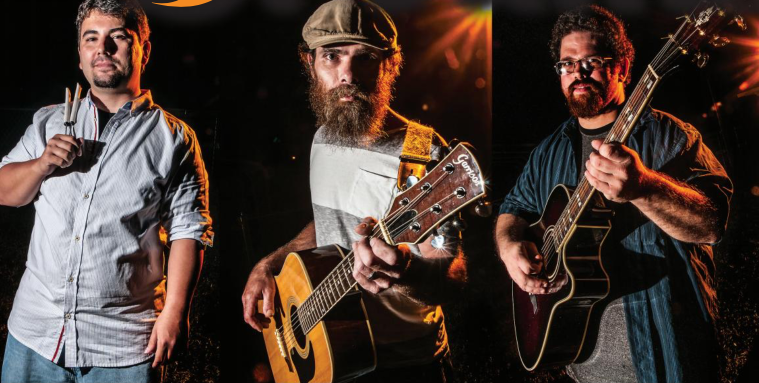
The band agrees that their highest time of tension is in the preparation and work that goes into setting up a show. “It is a production to put together a Dali show,” Bowman says. For a crew that is as musically versatile as they are vivacious, getting ready for a show is a lot of work.
“That’s probably our biggest obstacle,” Headrick says. “We are six people who have a lot of different talents in a lot of places.” Point blank, she adds, “We have a lot of crap.
“With every band, [lack of] money is something that keeps you from making life easier. If we had all the money in the world we’d have a trailer by now with a beautiful Kamikaze Dali logo on the side that would make our loading life a lot easier,” she continues. “But for right now, we end up with five cars to every gig to get everything in.”
They all agree that for about an hour during setup, nerve synapses are firing and the haze of tension is thick, but all of that pressure is relieved by the time the last instrument is unloaded and in place and the last cable plugged in.
Technically, the Dali’s first gig was in February of 2013, before they really got the chance to dive into a practice session. One year later, they decided to start booking shows, but were pleasantly surprised by the amount of shows that came to them.
They accredit their break into the Roman music scene, in large part, to their participation in the State Mutual Insurance Battle of the Bands last year at the Historic Desoto Theatre, which began weaving the Dali a web of connection and support amongst Romans and fellow local musicians.
They kicked off 2014 with a charity event for the Philippines called Bridge the Sea, returned to the Desoto in August to win the People’s Choice Award in the Battle of the Bands (which raised more than $11,000 for Cancer Navigators), played their second year on the river at Rome Beer Fest, and graced the stage at the Wings Over North Georgia Air Show; these among many other well-received Roman appearances.
The Dali has productive hopes for the year to come. “We definitely want to get in a recording studio,” Headrick says, “because up to this point we’ve done a lot of DIY recording.” (The Dali has a three-song album featuring “H.D. Heart,” “Keeping Up” and “Melt” available for digital download at thekamikazedali.bandcamp.com as well as reverbnation.com/thekamikazedali).
Branching out is a definitive goal for the band. They hope to venture into the music scenes of surrounding areas like Chattanooga, Birmingham and Athens and they look forward to getting their instruments in the door of the festival circuit, bringing a little “Bolivian Folk Death Grass” to the fields.
With a catalogue of 50 to 60 original songs and roughly 30 covers, thus far, the Dali has been a production in themselves, handling their own contacts, promotions, bookings and recording.
Helping and supporting the band every step of the way is the rest of the Dali family, ever so affectionately dubbed, “the Dali mamas.” Bowman’s wife, Jess; Wells’ wife, Kendra; and Headrick and Clark’s mothers can always be found in the audience, cheering them on and breaking in the dance floor. Kendra’s photography is also responsible for the majority of the Dali’s glamour shots.
“We’re really lucky to have them. They really have been a huge backbone for us since we got started,” Headrick smiles.
During this interview, as a part of the Dali’s circle, it was very evident that they – not just as musicians, but as people – are some fun-loving, joke-cracking fools. V3 picked up a little Dali knowledge, of which shall now be passed on:
• They love a good storytelling crowd.
• Conversations about facial hair can last a while, so sit a spell.
• For questions about current pop culture or MTV shenanigans, ask Headrick; also, she’s the only Dali member that is allowed to freely partake of pre-show adult beverages.
• If you’re at a Dali show, drink every time Weaver forgets the words; you may need a designated driver.
All jokes aside, with collectively more than a century’s worth of musical experience, years invested in strength of solidarity and a talent pool that is oceans deep, The Kamikaze Dali perseveres into the unknown of the future, a harmonious hexad – a family.
Book the band at kamikazedali@yahoo.com

